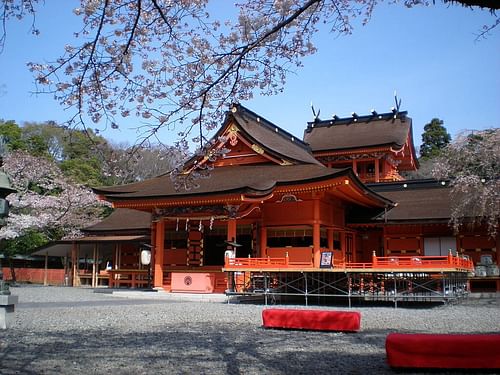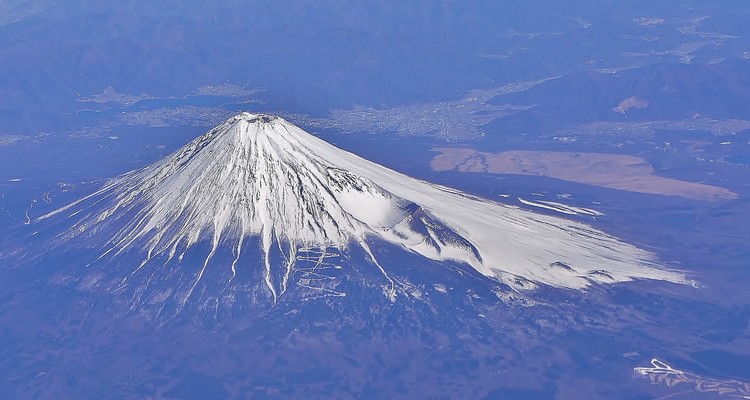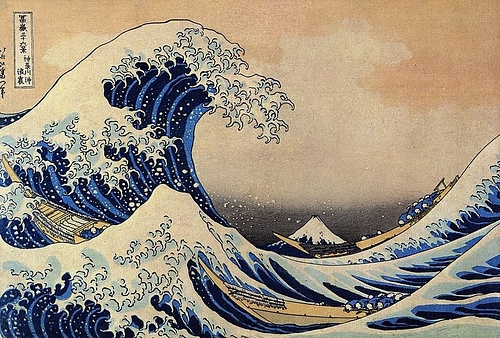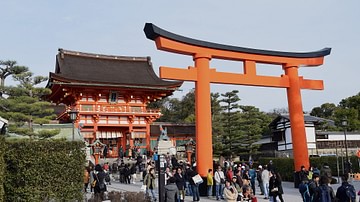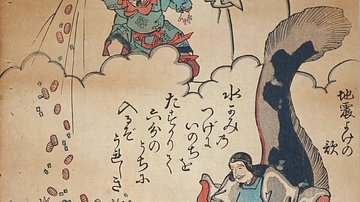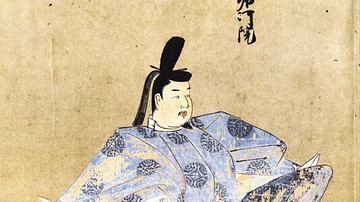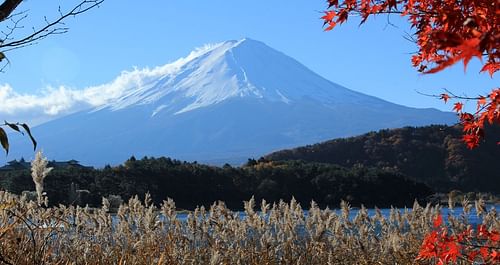
Mt. Fuji (Fujisan) is the tallest mountain in Japan and, with its classically symmetrical snow-capped cone, has long been the symbol of that country. The volcano is regarded as a sacred kami or spirit in the Shinto religion, specifically that of Princess Konohanasakuya-hime (aka Fuji-hime or Sengen), and climbing its slopes is considered an act of pilgrimage for followers of that faith. The mountain also has several important sacred shrines, caves, springs and a waterfall. As of 2013 CE Mt. Fuji is a UNESCO World Heritage Site.
Geography
Mt. Fuji, although generally envisaged as a single mountain, actually consists of three distinct volcanoes. Its classic symmetrical slopes are made all the more impressive by the mountain's isolation from any other peaks. Located on Honshu island and straddling the border between the Shizuoka and Yamanashi prefectures, Mt. Fuji is just 100 kilometres (60 miles) from Tokyo and can be seen from its tower blocks on a clear day. The mountain rises to a height of 3,776 metres (12,389 ft) and incorporates five lakes. The volcano is currently dormant with its last eruption occurring in 1708 CE, although between that date and 781 CE there were 17 eruptions recorded.
A Sacred Mountain
Considered sacred by the Ainu people, the indigenous inhabitants of ancient Japan, Mt. Fuji's name may derive from Fuchi, the Ainu god of fire and the hearth. Some Buddhist sects considered the mountain a holy place, and from the 12th century CE, it became a destination for those practising asceticism (shugendo) and seeking a 'rebirth' from their time on the mountain, in a mix of Buddhist, Taoist, and animist beliefs.
However, it is in the Shinto religion that Mt. Fuji holds a particularly special position. Eight major shrines were built around the foot of the mountain and hundreds of smaller ones have since been added. The most important Shinto shrine is the Fujisan Hongu Sengen Taisha which was first constructed in 806 CE, although by tradition, it was originally founded during the reign of Emperor Suinin (29 BCE - 70 CE) at another location at the foot of the mountain. The shrine's current building, with its unusual two storeys, dates to 1604 CE and the site is famous for its 500 cherry trees which blossom each April.
The Kawaguchi Asama Shrine was built in the 9th century CE in an effort to appease the anger of Fujisan after the eruptions of that century. In 1149 CE the Dainichiji temple was built near the peak by Matsudai Shonin where there is also a torii or sacred gate. Unlike most Shinto shrines, there is no honden building containing the goshintai, the sacred physical object which is the embodiment of the shrine's kami, as the mountain itself is regarded as that embodiment. There is also the shrine of Kitaguchi Hongu Fuji Sengen Jinja which was founded during the reign of Emperor Keiko (71-130 CE) but rebuilt in 1718 CE following the eruption eleven years earlier. It is one of the preferred starting points to reach the top, and its torii is over 18 metres (60 ft.) high, making it the largest in Japan. It is likely to keep that record as it is rebuilt every 60 years, each time a little taller than its predecessor.
Climbing the mountain was and still is regarded as an important pilgrimage, an act which became popular from the 15th century CE even for those with no particular religious affiliation. Being a holy site, though, climbers had to be accompanied by a monk or priest guide (Oshi). Prior to 1945 CE women, considered in Shinto to be a source of impurity (kegare), were not permitted to climb the sacred mountain. There are five ascent routes with a total of ten stations. The climb, usually undertaken in July or August when the snow has melted from the peak, takes anywhere from 4 to 8 hours. Some 400,000 people make the effort each year, a good many of them doing so at night in order to catch the auspicious sunrise while at the peak.
Sometime in the 15th century CE, a mythology developed which associated Mt. Fuji with Konohanasakuya-hime, a princess renowned for her beauty whose name translates as 'Flower-blossom Princess.' According to the Kojiki ('Record of Ancient Things' compiled in 712 CE), the princess, daughter of the mountain god Oyamatsumi no kami, descended to earth and became the wife of Ninigi no mikoto, grandson of the sun goddess Amaterasu and founder of Japan's imperial line. Konohanasakuya-hime became the goddess of Mt. Fuji. There are two lava caves formed by ancient trees being covered in a lava flow and then decomposing. Here adherents to the cult of Konohanasakuya-hime, known to Buddhists as Sengen, go through a ritual of 'rebirth.'
In the 17th century CE, Hasegawa Kakugyo founded a sect based on Mt. Fuji as the divine source of all life, which was popular in the 18th century CE and necessitated the building of 86 lodges. Kakugyo claimed he had seen the spirit of the mountain in a vision while he was practising asceticism in a cave on Fuji's slopes. Other sacred sites on the mountain include the Oshino Hakkai Springs which have an underground river as their source and the curved Shiraito Falls which are fed by the mountain's annual snowmelt.
Mt. Fuji is also believed to be a gathering point for the spirits of deceased ancestors, and prayers are offered to them as well as (prudently) safety from volcanic eruption, fire, and childbirth (a specific role of Konohanasakuya-hime). Even today, a dream in which Mt. Fuji appears is considered a sign of coming good fortune. Finally, the mountain not only has its own shrines but there are over 13,000 shrines spread across Japan which are dedicated to Fujisan. Many of these include small-scale replicas of the mountain which worshippers who are unable to climb the real thing ascend in symbolic pilgrimage.
Mt. Fuji in the Arts
Mt. Fuji has long captured the imagination of writers and artists. The 8th-century CE poetry anthology Manyoshu has several poems dedicated to the mountain; it appears smoking at the end of the c. 909 CE 'Tale of the Bamboo Cutter' (Taketori Monogatari), the oldest surviving work of Japanese fiction, and it is the setting of many medieval folktales. The mountain features in several of the haiku poems by Matsuo Basho (1644-1694 CE) too.
In the land of Yamato,
It is our treasure, our tutelary god.
It never tires our eyes to look up
To the lofty peak of Mount FujiManyoshu (Dougill, 17)
More recently, Fuji was famously captured in the ukiyo-e woodblock prints of the noted artist Katsushika Hokusai (1760-1849 CE) who produced a series known as the 'Thirty-Six Views of Mount Fuji' (Fugaku Sanjurokkei). One of the set, Beneath the Wave off Kanagawa, is perhaps the most famous of all Japanese artworks. The artist Utagawa Hiroshige (1797-1858 CE) was even more enraptured and produced an even bigger set of prints, his 'One Hundred Views of Mount Fuji' (Fuji Sanjurokkei) as well as his 'Fifty-Three Stations of the Tokaido Road' (Tokaido Gojusantsugi). The mountain also appears on the current 1000 Yen banknote.
This content was made possible with generous support from the Great Britain Sasakawa Foundation.
